-2023届高三英语二轮复习:语法专题之动词时态语态课件(50张ppt)
文档属性
| 名称 | -2023届高三英语二轮复习:语法专题之动词时态语态课件(50张ppt) | 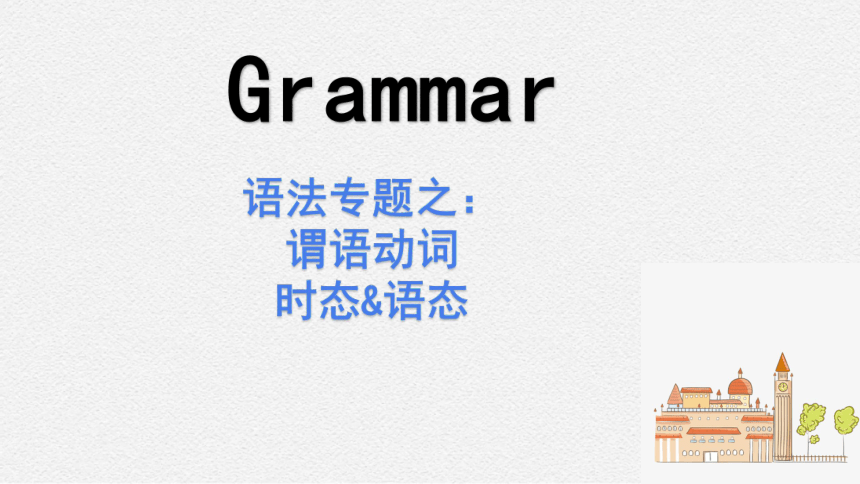 | |
| 格式 | pptx | ||
| 文件大小 | 1.8MB | ||
| 资源类型 | 教案 | ||
| 版本资源 | 通用版 | ||
| 科目 | 英语 | ||
| 更新时间 | 2022-12-09 14:34:04 | ||
图片预览

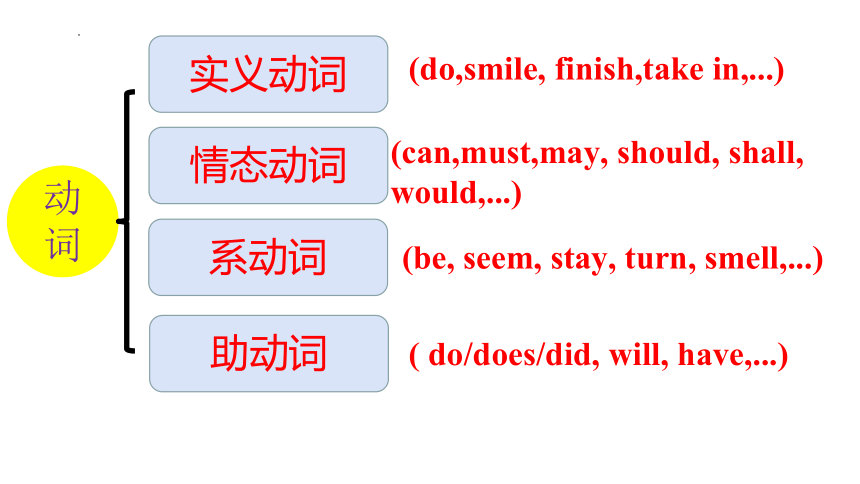
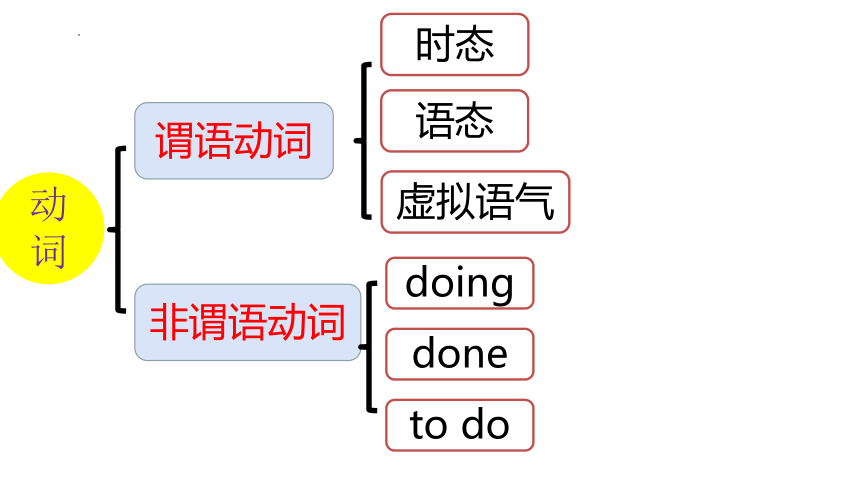

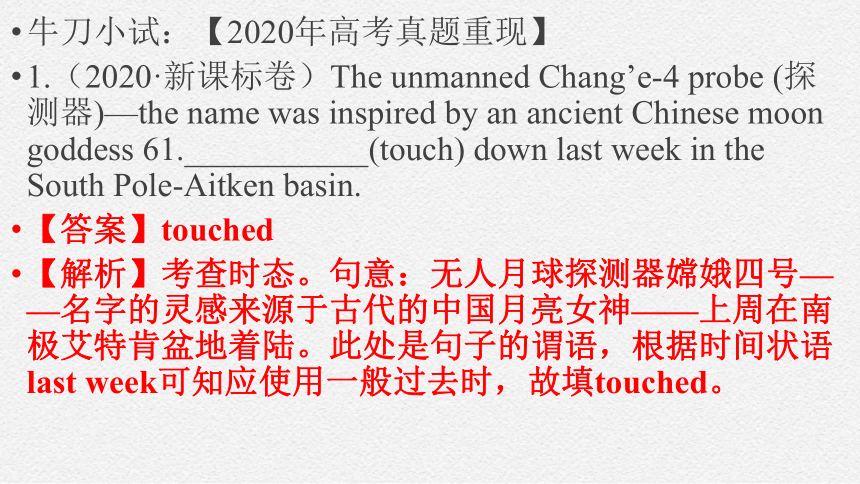
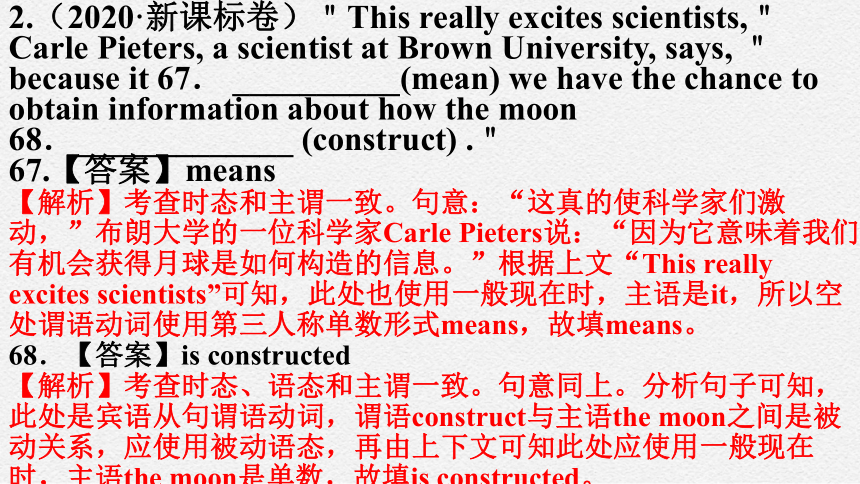


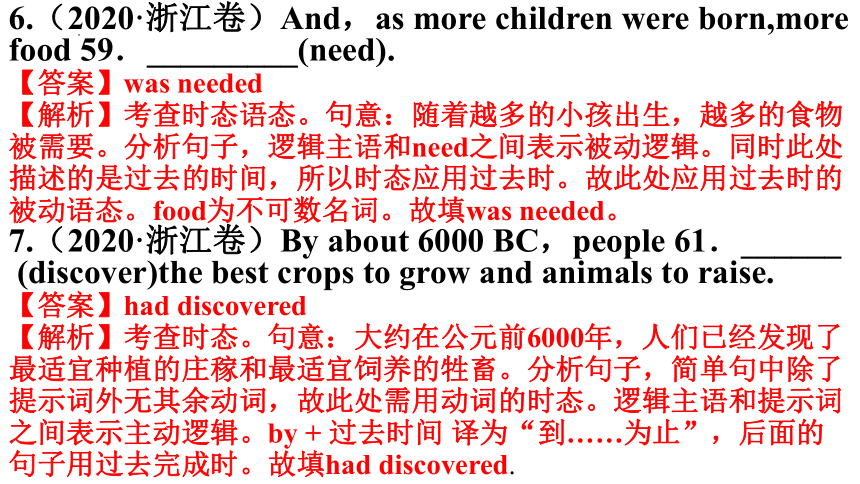
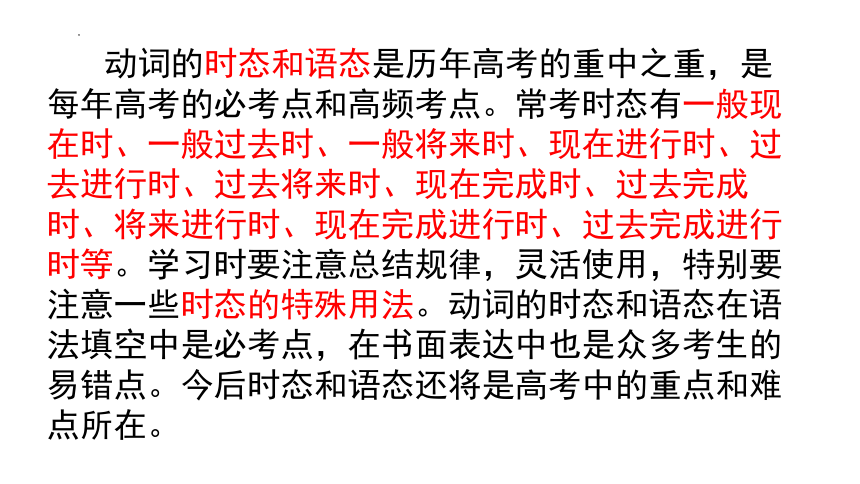
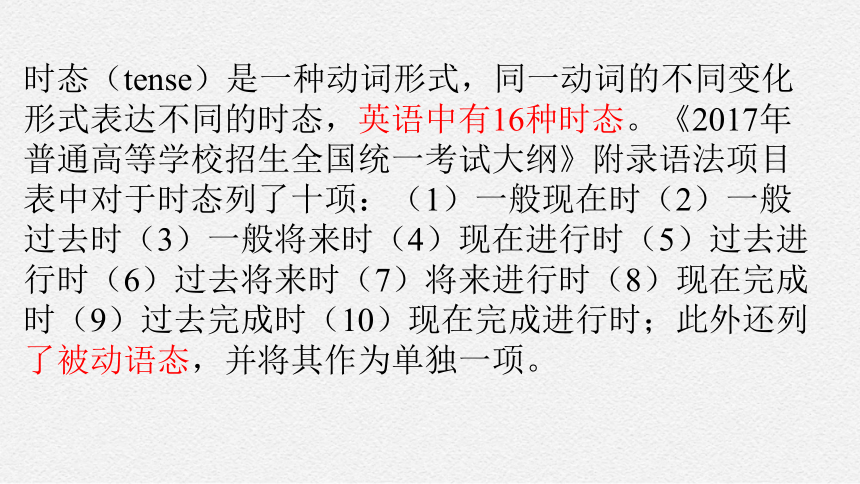
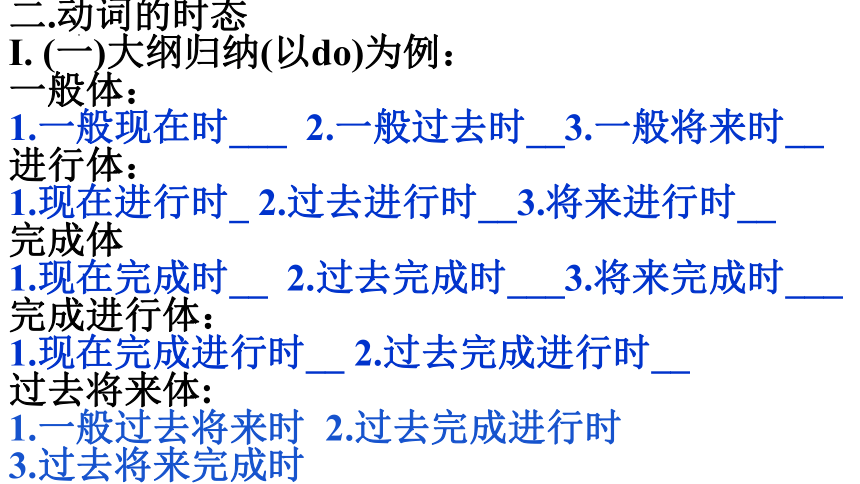
文档简介
(共50张PPT)
Grammar
语法专题之:
谓语动词
时态&语态
动词
实义动词
情态动词
系动词
助动词
(do,smile, finish,take in,...)
(can,must,may, should, shall,
would,...)
(be, seem, stay, turn, smell,...)
( do/does/did, will, have,...)
动词
谓语动词
非谓语动词
时态
语态
doing
done
to do
虚拟语气
谓语动词的时态
牛刀小试:【2020年高考真题重现】
1.(2020·新课标卷)The unmanned Chang’e-4 probe (探测器)—the name was inspired by an ancient Chinese moon goddess 61.___________(touch) down last week in the South Pole-Aitken basin.
【答案】touched
【解析】考查时态。句意:无人月球探测器嫦娥四号——名字的灵感来源于古代的中国月亮女神——上周在南极艾特肯盆地着陆。此处是句子的谓语,根据时间状语last week可知应使用一般过去时,故填touched。
2.(2020·新课标卷)"This really excites scientists," Carle Pieters, a scientist at Brown University, says, "because it 67. __________(mean) we have the chance to obtain information about how the moon 68._____________ (construct) ."
67.【答案】means
【解析】考查时态和主谓一致。句意:“这真的使科学家们激动,”布朗大学的一位科学家Carle Pieters说:“因为它意味着我们有机会获得月球是如何构造的信息。”根据上文“This really excites scientists”可知,此处也使用一般现在时,主语是it,所以空处谓语动词使用第三人称单数形式means,故填means。
68.【答案】is constructed
【解析】考查时态、语态和主谓一致。句意同上。分析句子可知,此处是宾语从句谓语动词,谓语construct与主语the moon之间是被动关系,应使用被动语态,再由上下文可知此处应使用一般现在时,主语the moon是单数,故填is constructed。
3.(2020·新课标卷)Actually, I ______(start) to learn kung fu when I was seven years old, I have long been out of practice.
【答案】started
【解析】考查时态。句意:事实上,我七岁时就开始学功夫了。分析句子,此处动词start讲述的是7岁的时候,动词应该用过去时。故将start改为started。
4.(2020·新课标卷)The artist was sure he would
63._________(choose), but when he presented his masterpiece to the emperor’s chief minister, the old nan laughed.
【答案】be chosen
【解析】考查动词语态。句意:画家确信他会被选中,但是当他把他的杰作送给皇帝的宰相时,这位老人笑了。本句中主语he与谓语动词choose构成被动关系,且would后跟动词原形。故填be chosen。
5.(2020·新课标卷) 65(When/As) he asked the villagers on the banks of the river where he could find the legendary (传奇的) artist, they smiled and 66._______ (point) down the river.
【答案】pointed
【解析】考查动词时态。句意:当他问河岸上的村民,他在哪里可以找到这位传奇艺术家时,他们笑着指着河的下游。根据上文they smiled and可知此处应用一般过去时。故填pointed。
6.(2020·浙江卷)And,as more children were born,more food 59._________(need).
【答案】was needed
【解析】考查时态语态。句意:随着越多的小孩出生,越多的食物
被需要。分析句子,逻辑主语和need之间表示被动逻辑。同时此处
描述的是过去的时间,所以时态应用过去时。故此处应用过去时的
被动语态。food为不可数名词。故填was needed。
7.(2020·浙江卷)By about 6000 BC,people 61.______
(discover)the best crops to grow and animals to raise.
【答案】had discovered
【解析】考查时态。句意:大约在公元前6000年,人们已经发现了
最适宜种植的庄稼和最适宜饲养的牲畜。分析句子,简单句中除了
提示词外无其余动词,故此处需用动词的时态。逻辑主语和提示词
之间表示主动逻辑。by + 过去时间 译为“到……为止”,后面的
句子用过去完成时。故填had discovered.
动词的时态和语态是历年高考的重中之重,是每年高考的必考点和高频考点。常考时态有一般现在时、一般过去时、一般将来时、现在进行时、过去进行时、过去将来时、现在完成时、过去完成时、将来进行时、现在完成进行时、过去完成进行时等。学习时要注意总结规律,灵活使用,特别要注意一些时态的特殊用法。动词的时态和语态在语法填空中是必考点,在书面表达中也是众多考生的易错点。今后时态和语态还将是高考中的重点和难点所在。
时态(tense)是一种动词形式,同一动词的不同变化形式表达不同的时态,英语中有16种时态。《2017年普通高等学校招生全国统一考试大纲》附录语法项目表中对于时态列了十项:(1)一般现在时(2)一般过去时(3)一般将来时(4)现在进行时(5)过去进行时(6)过去将来时(7)将来进行时(8)现在完成时(9)过去完成时(10)现在完成进行时;此外还列了被动语态,并将其作为单独一项。
二.动词的时态
I. (一)大纲归纳(以do)为例:
一般体:
1.一般现在时___ 2.一般过去时__3.一般将来时__
进行体:
1.现在进行时_ 2.过去进行时__3.将来进行时__
完成体
1.现在完成时__ 2.过去完成时___3.将来完成时___
完成进行体:
1.现在完成进行时__ 2.过去完成进行时__
过去将来体:
1.一般过去将来时 2.过去完成进行时
3.过去将来完成时
(以动词do为例) 一般时态 进行时态 完成时态 完成进行时态
现 在
过 去
将 来
过去将来
(以动词do为例) 一般时态 进行时态 完成时态 完成进行时态
现 在 do/does is/am/are doing has/have done has/have been doing
过 去 did was /were doing had done had been doing
将 来 shall/will do shall/will be doing shall/will have done shall/will have been doing
过去将来 would do would be doing would have done would have been doing
1)He gets up at 6:00 o'clock every morning and it usually takes him an hour to drive to work.
II. 基本用法:一般体
(一) 一般现在时(am/is/are或do/does)
1.表示经常发生的、习惯性的、反复出现的动作或状态。
(此用法常与表示习惯的副词(词组)always,every time,
now and then,occasionally,often,seldom,sometimes,
usually,every day/night等连用)
2.表示客观真理、科学事实 、格言。
2)The earth travels around the sun.
3)The teacher said the earth travels around the sun.
(注:客观真理的一般时态不受周围语境时态的影响)
II. 基本用法:一般体
(一) 一般现在时(am/is/are或do/does)
3.用在时间、条件或让步状语从句中, 用一般现在时表将来。(即“主将从现”原则)
3)When I grow up, I will be a nurse and look after patients.
4.按时间表、时刻表、日程表等安排将要发生的动作,用
一般现在时。(一般现在时表将来)
4)The flight takes off at 2:30 this afternoon.
(注意: 此用法只限于go,arrive,leave,start,stay,return,begin,come等动词)
5.在here/there引导的倒装句中,用一般时表进行时态.
5) There goes the bell! 6)Here comes the bus.
例句造句:1.我们每天上7节课.2.太阳从东方升起.3.老师来了!
1.We have 7 classes every day.
2.The sun rises in the east.
3.Here comes the teacher!
II. 基本用法:一般体
(二) 一般过去时(was/were或did)
1.表示在过去某一时间点发生的动作、所处的状态或表示
过去一段时间内习惯性的或反复发生的动作。
1)I went to Ningxia and stayed there for one year, teaching as a volunteer.
(注意:此用法常与表过去的时间状语连用,如yesterday, the day
before yesterday, for +一段时间,时间+ ago,in+2018(年份),last year/week, then, at that time, just now, the other day)
2)When he was a student, he always went to the libarary.
(表过去习惯性动作,常与always, often, every time等连用)
造句练习:他2014年从大学毕业,在伦敦一所学校当了四年老师,但是去年已经返回了家乡。
He graduated from university in 2014,and worked as a teacher in London for 4 years,but returned to his hometown last year.
II. 基本用法:一般体
(三) 一般将来时(shall/will do)
1.表示客观性或必然性的将来。
1)What I want to tell you is that I shall be thirty next year.
Fish will die without water.
2.表示对将来情况的推测.
2)Follow the doctor's advice, and you will recover soon.
(特殊句型: 祈使句+and/or +陈述句)
造句:听从医生的建议吧,否则你之后会后悔的.
Follow the doctor's advice, or you will regret it later.
3.表说话者事先未经过考虑,听到话语后而临时做出的决定。
3)---Did you tell Julia about the result
----Oh, I forgot. I will call her now.
II. 基本用法:一般体
(三) 一般将来时(shall/will do)
扩展:其他几种表示将来时的形式:
be going to ; be to do; be about to do; be doing
1.I am going to visit my uncle at home tonight.
(①主语现在打算或计划将来要做的事情,强调个人计划)
2.Look at the clouds! It's going to rain!
(②某种迹象将来要发生的事情)
3.A meeting is to be held at 3 o’clock this afternoon.
(预先安排好的计划或约定,强调客观计划,非人为随意可改变)
4. I was about to go out when it begins to rain.
(表示正要或即将要做某事,该结构不与表示将来的时间状语连用,be about to do ... when为固定搭配,表示“正要做……突然……”)
5.Hurry up! The train is leaving!
(按计划或安排即将发生的动作,常限于go,come, leave,start,arrive,return等表示移动方向的动词)
提升造句
A.如果你不听我的话,你会感冒的.B. 树叶会在秋季的时候变成黄色.C.我忘带书了!我这回去拿.D.他正要上床睡觉,这时电话响了.
A.If you didn't follow my advice, you'll catch a cold.
B.Leaves will turn yellow in autumn.
C.I forgot my book! I'll take it now.
D.He was about to go to bed when the telephone
rang.
II. 基本用法:进行体
(一) 现在进行时(am/is/are doing)
1.表示说话时正在进行或现阶段正在进行的动作.
1)Linda's brother is watching TV in his bedroom now.
He's writing a novel these days.
(此时态经常与now, at the moment, these days等连用)
2.与频度副词always,forever,continually,constantly等连用时表示重复的动作,有着极大的感彩,表示某种感彩(赞许、厌烦、满意等)。
2)My wife is always complaining about this or that.
3.表示按计划或安排即将发生的动作,常限于go,come, leave,start,arrive,return,stay,have等表示移动、方向的动词。
3)I'm leaving tonight. I've bought my ticket.
A.他们目前在召开会议.B.他这几周都在为考试做准备.C.你总是犯同样的错误!
A.They're holding a meeting now.
B.He is preparing for the exam these weeks.
C.You're always making the same mistake!
II. 基本用法:进行体
(二) 过去进行时(was/were doing)
1).表示在过去某时刻正在进行或发生的动作.
1)She was phoning someone, so I nodded to her and went away.
(通常与表过去的时间状语at that time,at that moment,
at this time yesterday,at ten o'clock yesterday等连用)
2.表移动的动词,如come, go, arrive, leave, start, begin, return等词的过去进行时,可以表示过去将要发生的动作。
2)She told me that she was going to Hainan for her holiday.
她告诉我她将去海南度假。
II. 基本用法:进行体
(三) 将来进行时(will be doing)
表示将来某一时刻正在进行的动作,经常与表将来的时间状语连用.
Daniel's family will be enjoying their holiday in Huangshan this time next week.
II. 基本用法:完成体
(一) 现在完成时(have/has done)
1.表示过去发生或已经完成的动作对现在造成的影响或结果.
1)I have no money to buy the coat. I have lost my wallet
three days ago.
(常与already, yet, ever, never, just,before等词连用)
2.表示过去已经开始,持续到现在的动作或状态。往往和
表示一段时间的时间状语连用。
2)They have learned English for eight years.
(注意:此时态中的谓语动词必须是延续性动词,且常与固定
的时间状语连用,如in/during the last/past...years, recently,
in recent years,since+时间点/时间状语从句,for+一段时间,
so far/up to now/until now等)
II. 基本用法:完成体
(一) 现在完成时(have/has done)
3.下列句型中常用现在完成时。
①It has been two years since we met.
(It is(has been)+一段时间+since从句(过去时) “自从...以来已经多久了.”
②This the the first time that I've visited Xiamen.
(“This(That/It)is the first(second ... )time that ... (谓语动词用现在完成时” 意为“这是某人第几次做某事)
③This is the most beautiful place that I've been to.
(“This(That/It)is the best/finest/most interesting+名词+that 从句(谓语动词用现在完成时)”,这是最...的...”.
提升练习:
1.我之前从来没有听说过这样的消息!
2.自从我上高中以来,我交到了很多新朋友.
3.自从他戒烟以来已经两周了.
4.这是你第三次犯同样的错误了!
1.I have never heard of the news like this !
2.I have made a lot of new friends since I went to the
senior high school.
3.It has been two weeks since he gave up smoking.
4.This is the third time that you've made the same mistake.
II. 基本用法:完成体
(二) 过去完成时(had done)
1.表示在过去某一时刻或动作之前完成的动作,即“过去的过去”。可以用by,before等介词短语或一个时间状语从句来表示动作发生的时间。
1)Lily had just left when we arrived。
2)By the end of last year, he had published five books.
2. 现在完成时的固定句型:
3) The game had hardly begun when it started raining.
(hardly...when+从句 ,意为”一...就...”,此时从句用过去时,
主句用过去完成时.此结构也可以换成no sooner ...than+从句)
4)This was the third time that he had made the same mistake.
(This/It was the +序数词+time +that从句(过去完成时)
II. 基本用法:完成体
2. 现在完成时的固定句型:
3)By the time he was 14, he had left for London.
造句提升:
1)在他们遇见之前,她已经知道他的大部分信息了.
2)他刚回到家就开始下雨了.
3)到上个月为止,他们已经上完所有的课程了.
1).She had known most of his information before they met.
2).He had hardly arrived home when it began to rain.
3) By the end of last month, they had finsihed all classes.
(By the time+从句, 从句用过去时,主句则用过去完成时.”
II. 基本用法:完成体
(三) 将来完成时(will have done)
在将来某个时间之前已完成的动作,常与by+将来时间连用.
We will have graduated from university by 2025.
II. 基本用法:完成进行体
现在完成进行时(has/have been doing)
表示一个从过去开始到现在仍在进行的动作,或一个从过去开始一直延续到现在,且重复发生的动作,强调持续性和未完成性.
--What're you up to
---I have been studying for the whole morning,and it's so tiring!
2. have done &have been doing&had done的区别:
A. He _________________(write) homework for a day and
he ____________(finish) most of them.
B. He _____________(finish) his homework by the end of
last week.
has been writing
has finished
had finished
II. 基本用法:过去将来体
过去将来时(would do)
(表示从过去的时间看将来发生的动作,即立足过去看来,常用于间接引语中)
The couple said they would buy a big house after they saved enough money.
时态语态做题技巧1. 找准时间状语;
What I want to tell you is that I shall be thirty next year.2. 没有明确的时间状语看语境、看句意;
She was phoning someone, so I nodded to her and went away.3. 找其他的动词 (look, listen);
Lily had just left when we arrived。4. 看是否是特殊的句式;
It has been two years since we met.5. 语态: 看动词和主语的关系是主动or被动The room___________________(clean) when he arrived.
had been cleaned
/was being cleaned
※被动语态
一.基本含义被动语态是动词的一种形式,用以说明主语与谓语动词之间的关系。被动语态表示主语是动作的承受者。一般来说,只有及物动词才有被动语态。汉语往往用“被、受、给”等动词来表示被动意义。
二.各种时态的被动语态形式:
一般式 进行式 完成式
现在时
过去时
将来时
过去将来时
一般式 进行式 完成式
现在时 am/is/are+done am/is/are+being+done have/has+been
+done
过去时 was/were+done was/were+being+done had+been+
done
将来时 shall/will be+done shall/will+have been+done
过去将来时 would/should be+done would/should+have been+done
1.英语中有很多动词,如break,catch,clean,drive,look,open,sell,read,write,wash等,当它们被用作不及物动词来描述主语特征时,常用其主动形式表达被动意义,主语通常是物;在这种情况下,常常和easily,well等副词连用。
I wash the cloth and find that it washes easily.
2.表示感受、感官的系动词feel,sound,taste,look等后跟形容词、名词构成系表结构,无被动形式。
The food smells good and tastes delicious.
主动形式表示被动意义的几种情况:
主动形式表示被动意义的几种情况:
3.在need,want,require,deserve,bear等动词、worth等形容词的后面,动名词用主动形式表示被动意义,其含义相当于动词不定式的被动形式。
The windows are so dirty that they need cleaning.
/to be done.
III.课后训练
(一)动词时态语态基本练习:1.Jack __________________(work) in the lab when someone called his named.2.The meeting _____________________(discuss) now and the decision ______________________(make) in two hours.3. The song is very familiar to us because it _____________________________(teach) many times.4.This Monday morning I was told that I ___________(choose) as one of the exchange students in our school.5. I was nervous when I _________________________(asked) by them,“What're you doing here now ”
was working
is being discussed
will be made
has been taught
had been chosen
was asked/was being asked
III.课后训练
(二)动词时态语态基本练习:1. I usually ______ up at 6:00, but yesterday I _________ up at 7:00 and tomorrow I _________ up at 6:30. (get)2. Listen! Someone ____________ (knock) at the door.3. He fell asleep while he ___________ (read) a book.4. I ________ never _______ (hear) of that man before.5. My brother often _________ (go) for walks last summer.6. Lily said she ____________ (put) on the new dress the
next day.7. If it ______________ (not rain) tomorrow, they
___________ (go) fishing. 8. By the time I _________ (walk) into the classroom, the
teacher ___________ (start) teaching.
get
got
will get
is knocking
was reading
have
heard
went
would put
doesn't rain
will go
walked
had started
※时态与语态解题技巧
一.时态语态不分家,综合分析最可靠
近几年,高考命题不单纯考查某一种时态的用法,而是多种时态交叉在一起,而且时态与语态一并考查,这就要求考生做题时不能仅根据一个方面去判断答案,而要进行全面综合的考虑。这就要求考生分析问题的时候,必须把时态、语态结合起来,同时要注意主谓保持一致。
1)If nothing ___________(do), the oceans will turn into fish deserts.
2)The teacher , along with his students, _______________ (wait) anxiously outside the lecture hall since 3:00 o'clock.
is done
has been waiting
二.分清谓语动词和非谓语动词,做题不易出差错.
在语法填空或短文改错中,经常出现的一类试题就是要求考生分辨清楚谓语非谓语的问题。考生应该首先通过对句子进行分析,从而确定句子中到底缺少谓语动词还是非谓语动词,然后再进行下一步的工作。如确定句子中缺少谓语动词,考生应该考虑的问题就是时态、语态和主谓一致;如确定句子中缺少非谓语动词,考生应该考虑的问题就是现在分词、过去分词和动词不定式。
※时态与语态解题技巧
_________(pick) up her“Lifetime Achievement”award,proud Irene ___________(declare) she had no plans __________ (retire) from her 36-year-old business.
Picking
declared
to retire
※时态与语态解题技巧
三.重点识记 不规则动词的变化规则.
1.China’s high-speed railways ___________(grow) from 9,000 to 25,000 kilometers in the past few years. (2018)
2. A boy on a bike _________(catch) my attention. He was riding beside the bus and waving his arms. (2015)
3.Last month, the family as well as their dog, ___________(trap) on the roof by the flood.
have grown
caught
was trapped
III.课后训练
(三)高考真题链接:
1.(2020·新课标 I 卷)The unmanned Chang’e-4 probe (探测器)—the name was inspired by an ancient Chinese moon goddess ________ (touch) down last week in the South Pole-Aitken basin.
2.(2020·新课标 I 卷)"This really excites scientists," Carle Pieters, a scientist at Brown University, says, "because it___________ (mean) we have the chance to obtain information about how the moon _______________ (construct) ."
3.(2020·新课标II卷)Actually, I ________(start) to learn kung fu
when I was seven years old, I have long been out of practice.
4.(2020·新课标 III 卷)The artist was sure he would
__________(choose), but when he presented his masterpiece to the emperor’s chief minister, the old man laughed.
5.(2020·新课标 III 卷)When/As he asked the villagers on the banks of the river where he could find the legendary (传奇的) artist, they smiled and ___________ (point) down the river.
touched
means
is constructed
started
be chosen
pointed
III.课后训练
(三)高考真题链接:
6.(2020·浙江卷)And,as more children were born,more food _______________(need).
7.(2020·浙江卷)By about 6000 BC,people ___________ (discover)the best crops to grow and animals to raise.
8.(2020·浙江卷)New methods ___________ (mean)that fewer
people worked in farming.
9.(2020·山东卷)The 80,000 objects collected by Sir Hans Sloane,
for example, ___________(form) the core collection of the British Museum which opened in 1759.
10.(2020·山东卷)The parts of a museum open to the public
________ (call) galleries or rooms.
11.(2020·天津卷)—You are a great swimmer.
—Thanks. It’s because I ___________________ (practice)a lot these days.
12.(2020·天津卷)The number of medical schools reached 18 in
the early 1990s and _____________ (remain) around that level since.
was needed
had discovered
meant
formed
are called
have been practising
has remained
III.课后训练
(三)高考真题链接:
13.(2020·江苏卷)If you look at all sides of the situation, you'll find probably a solution that __________ (suit)everyone.
14.(2020·江苏卷)Instead of getting down to a new task as I _______________(expect), he examined the previous work again.
15.【2019·江苏卷】The musician along with his band members ______________(given) ten performances in the last three months.
16.【2019·江苏卷】A few months after he had arrived in China, Mr. Smith ___________(fall) in love with the people and culture there.
17.【2019·江苏卷】They are trying to make sure that 5G terminals________________________(install) by 2022 for the Beijing Winter Olympics.
18.【2019·天津卷】I _____________ (hope) to send Peter a gift to congratulate him on his marriage,but I couldn't manage it.
19.【2019·天津卷】Amy, as well as her brothers, ____________
(give)a warm welcome when returning to the village last week.
suits
had expected
has given
fell
will have been installed
had hoped
was given
III.课后训练
(三)高考真题链接:
20.【2019·新课标 I 卷】 Of the nineteen recognized polar bear subpopulations, three are declining, six __________ (be) stable, one is increasing, and nine lack enough data.
21.【2019·新课标 II 卷】Picking up her“Lifetime Achievement”award,proud Irene ___________(declare) she had no plans __________ (retire) from her 36-year-old business.
22.【2019·新课标 II 卷】I don't see any reason to give up work. I love coming here and seeing my family and all the friends I __________(make) over the years
23.【2019·新课标 III 卷】Our hosts shared many of their experiences and______________(recommend)wonderful places to eat,shop,
and visit.
24.【2019·新课标 III 卷】On the last day of our week-long stay,we __________ (invite)to attend a private concert on a beautiful farm on the North Shore under the stars .
were
decalred
to retire
have made
recommended
were invited
Ⅲ. 语法填空 Saint Patrick's Day is a major holiday in Ireland, but the rest of the world has influenced its celebration as much as the Irish __1__(they). Most Americans think of Saint Patrick's Day as a big party __2__(center)around drinking alcohol. But its __3__(origin)in Ireland were religious, says Mike Cronin, a professor of Irish history with Boston College of Massachusetts.Saint Patrick lived in Ireland more than 2,000 years ago. He is __4__(wide)considered to have established Christianity in the country. The Church decided to honor him with a holy day. March 17, the date of his death, __5__(choose)in the 17th century.
1.themselves 2.centered(过去分词做定语,非谓语)
3.origins 4.widely 6.was chosen (谓语动词的被动)
St. Patrick is believed __6__(serve)in Ireland as a Catholic Bishop(主教). The average Irish person honored March 17 quietly. __7__(attend)church services was the main activity. In fact, most businesses that served alcohol would close in honor __8__ the day. In the early 1900s, Ireland's government made St. Patrick's Day __9__ official holiday. By the 1960s, towns across Ireland started celebrating the holiday with parades and music.In Ireland today, St. Patrick's Day is a four day public celebration __10___ includes parades, music, food, and games.
6. to have served (be believed to do/have done...被认为是/已经...
7. attending (v-ing做定语修饰person)
8.of 9.an 10.which/that
Grammar
语法专题之:
谓语动词
时态&语态
动词
实义动词
情态动词
系动词
助动词
(do,smile, finish,take in,...)
(can,must,may, should, shall,
would,...)
(be, seem, stay, turn, smell,...)
( do/does/did, will, have,...)
动词
谓语动词
非谓语动词
时态
语态
doing
done
to do
虚拟语气
谓语动词的时态
牛刀小试:【2020年高考真题重现】
1.(2020·新课标卷)The unmanned Chang’e-4 probe (探测器)—the name was inspired by an ancient Chinese moon goddess 61.___________(touch) down last week in the South Pole-Aitken basin.
【答案】touched
【解析】考查时态。句意:无人月球探测器嫦娥四号——名字的灵感来源于古代的中国月亮女神——上周在南极艾特肯盆地着陆。此处是句子的谓语,根据时间状语last week可知应使用一般过去时,故填touched。
2.(2020·新课标卷)"This really excites scientists," Carle Pieters, a scientist at Brown University, says, "because it 67. __________(mean) we have the chance to obtain information about how the moon 68._____________ (construct) ."
67.【答案】means
【解析】考查时态和主谓一致。句意:“这真的使科学家们激动,”布朗大学的一位科学家Carle Pieters说:“因为它意味着我们有机会获得月球是如何构造的信息。”根据上文“This really excites scientists”可知,此处也使用一般现在时,主语是it,所以空处谓语动词使用第三人称单数形式means,故填means。
68.【答案】is constructed
【解析】考查时态、语态和主谓一致。句意同上。分析句子可知,此处是宾语从句谓语动词,谓语construct与主语the moon之间是被动关系,应使用被动语态,再由上下文可知此处应使用一般现在时,主语the moon是单数,故填is constructed。
3.(2020·新课标卷)Actually, I ______(start) to learn kung fu when I was seven years old, I have long been out of practice.
【答案】started
【解析】考查时态。句意:事实上,我七岁时就开始学功夫了。分析句子,此处动词start讲述的是7岁的时候,动词应该用过去时。故将start改为started。
4.(2020·新课标卷)The artist was sure he would
63._________(choose), but when he presented his masterpiece to the emperor’s chief minister, the old nan laughed.
【答案】be chosen
【解析】考查动词语态。句意:画家确信他会被选中,但是当他把他的杰作送给皇帝的宰相时,这位老人笑了。本句中主语he与谓语动词choose构成被动关系,且would后跟动词原形。故填be chosen。
5.(2020·新课标卷) 65(When/As) he asked the villagers on the banks of the river where he could find the legendary (传奇的) artist, they smiled and 66._______ (point) down the river.
【答案】pointed
【解析】考查动词时态。句意:当他问河岸上的村民,他在哪里可以找到这位传奇艺术家时,他们笑着指着河的下游。根据上文they smiled and可知此处应用一般过去时。故填pointed。
6.(2020·浙江卷)And,as more children were born,more food 59._________(need).
【答案】was needed
【解析】考查时态语态。句意:随着越多的小孩出生,越多的食物
被需要。分析句子,逻辑主语和need之间表示被动逻辑。同时此处
描述的是过去的时间,所以时态应用过去时。故此处应用过去时的
被动语态。food为不可数名词。故填was needed。
7.(2020·浙江卷)By about 6000 BC,people 61.______
(discover)the best crops to grow and animals to raise.
【答案】had discovered
【解析】考查时态。句意:大约在公元前6000年,人们已经发现了
最适宜种植的庄稼和最适宜饲养的牲畜。分析句子,简单句中除了
提示词外无其余动词,故此处需用动词的时态。逻辑主语和提示词
之间表示主动逻辑。by + 过去时间 译为“到……为止”,后面的
句子用过去完成时。故填had discovered.
动词的时态和语态是历年高考的重中之重,是每年高考的必考点和高频考点。常考时态有一般现在时、一般过去时、一般将来时、现在进行时、过去进行时、过去将来时、现在完成时、过去完成时、将来进行时、现在完成进行时、过去完成进行时等。学习时要注意总结规律,灵活使用,特别要注意一些时态的特殊用法。动词的时态和语态在语法填空中是必考点,在书面表达中也是众多考生的易错点。今后时态和语态还将是高考中的重点和难点所在。
时态(tense)是一种动词形式,同一动词的不同变化形式表达不同的时态,英语中有16种时态。《2017年普通高等学校招生全国统一考试大纲》附录语法项目表中对于时态列了十项:(1)一般现在时(2)一般过去时(3)一般将来时(4)现在进行时(5)过去进行时(6)过去将来时(7)将来进行时(8)现在完成时(9)过去完成时(10)现在完成进行时;此外还列了被动语态,并将其作为单独一项。
二.动词的时态
I. (一)大纲归纳(以do)为例:
一般体:
1.一般现在时___ 2.一般过去时__3.一般将来时__
进行体:
1.现在进行时_ 2.过去进行时__3.将来进行时__
完成体
1.现在完成时__ 2.过去完成时___3.将来完成时___
完成进行体:
1.现在完成进行时__ 2.过去完成进行时__
过去将来体:
1.一般过去将来时 2.过去完成进行时
3.过去将来完成时
(以动词do为例) 一般时态 进行时态 完成时态 完成进行时态
现 在
过 去
将 来
过去将来
(以动词do为例) 一般时态 进行时态 完成时态 完成进行时态
现 在 do/does is/am/are doing has/have done has/have been doing
过 去 did was /were doing had done had been doing
将 来 shall/will do shall/will be doing shall/will have done shall/will have been doing
过去将来 would do would be doing would have done would have been doing
1)He gets up at 6:00 o'clock every morning and it usually takes him an hour to drive to work.
II. 基本用法:一般体
(一) 一般现在时(am/is/are或do/does)
1.表示经常发生的、习惯性的、反复出现的动作或状态。
(此用法常与表示习惯的副词(词组)always,every time,
now and then,occasionally,often,seldom,sometimes,
usually,every day/night等连用)
2.表示客观真理、科学事实 、格言。
2)The earth travels around the sun.
3)The teacher said the earth travels around the sun.
(注:客观真理的一般时态不受周围语境时态的影响)
II. 基本用法:一般体
(一) 一般现在时(am/is/are或do/does)
3.用在时间、条件或让步状语从句中, 用一般现在时表将来。(即“主将从现”原则)
3)When I grow up, I will be a nurse and look after patients.
4.按时间表、时刻表、日程表等安排将要发生的动作,用
一般现在时。(一般现在时表将来)
4)The flight takes off at 2:30 this afternoon.
(注意: 此用法只限于go,arrive,leave,start,stay,return,begin,come等动词)
5.在here/there引导的倒装句中,用一般时表进行时态.
5) There goes the bell! 6)Here comes the bus.
例句造句:1.我们每天上7节课.2.太阳从东方升起.3.老师来了!
1.We have 7 classes every day.
2.The sun rises in the east.
3.Here comes the teacher!
II. 基本用法:一般体
(二) 一般过去时(was/were或did)
1.表示在过去某一时间点发生的动作、所处的状态或表示
过去一段时间内习惯性的或反复发生的动作。
1)I went to Ningxia and stayed there for one year, teaching as a volunteer.
(注意:此用法常与表过去的时间状语连用,如yesterday, the day
before yesterday, for +一段时间,时间+ ago,in+2018(年份),last year/week, then, at that time, just now, the other day)
2)When he was a student, he always went to the libarary.
(表过去习惯性动作,常与always, often, every time等连用)
造句练习:他2014年从大学毕业,在伦敦一所学校当了四年老师,但是去年已经返回了家乡。
He graduated from university in 2014,and worked as a teacher in London for 4 years,but returned to his hometown last year.
II. 基本用法:一般体
(三) 一般将来时(shall/will do)
1.表示客观性或必然性的将来。
1)What I want to tell you is that I shall be thirty next year.
Fish will die without water.
2.表示对将来情况的推测.
2)Follow the doctor's advice, and you will recover soon.
(特殊句型: 祈使句+and/or +陈述句)
造句:听从医生的建议吧,否则你之后会后悔的.
Follow the doctor's advice, or you will regret it later.
3.表说话者事先未经过考虑,听到话语后而临时做出的决定。
3)---Did you tell Julia about the result
----Oh, I forgot. I will call her now.
II. 基本用法:一般体
(三) 一般将来时(shall/will do)
扩展:其他几种表示将来时的形式:
be going to ; be to do; be about to do; be doing
1.I am going to visit my uncle at home tonight.
(①主语现在打算或计划将来要做的事情,强调个人计划)
2.Look at the clouds! It's going to rain!
(②某种迹象将来要发生的事情)
3.A meeting is to be held at 3 o’clock this afternoon.
(预先安排好的计划或约定,强调客观计划,非人为随意可改变)
4. I was about to go out when it begins to rain.
(表示正要或即将要做某事,该结构不与表示将来的时间状语连用,be about to do ... when为固定搭配,表示“正要做……突然……”)
5.Hurry up! The train is leaving!
(按计划或安排即将发生的动作,常限于go,come, leave,start,arrive,return等表示移动方向的动词)
提升造句
A.如果你不听我的话,你会感冒的.B. 树叶会在秋季的时候变成黄色.C.我忘带书了!我这回去拿.D.他正要上床睡觉,这时电话响了.
A.If you didn't follow my advice, you'll catch a cold.
B.Leaves will turn yellow in autumn.
C.I forgot my book! I'll take it now.
D.He was about to go to bed when the telephone
rang.
II. 基本用法:进行体
(一) 现在进行时(am/is/are doing)
1.表示说话时正在进行或现阶段正在进行的动作.
1)Linda's brother is watching TV in his bedroom now.
He's writing a novel these days.
(此时态经常与now, at the moment, these days等连用)
2.与频度副词always,forever,continually,constantly等连用时表示重复的动作,有着极大的感彩,表示某种感彩(赞许、厌烦、满意等)。
2)My wife is always complaining about this or that.
3.表示按计划或安排即将发生的动作,常限于go,come, leave,start,arrive,return,stay,have等表示移动、方向的动词。
3)I'm leaving tonight. I've bought my ticket.
A.他们目前在召开会议.B.他这几周都在为考试做准备.C.你总是犯同样的错误!
A.They're holding a meeting now.
B.He is preparing for the exam these weeks.
C.You're always making the same mistake!
II. 基本用法:进行体
(二) 过去进行时(was/were doing)
1).表示在过去某时刻正在进行或发生的动作.
1)She was phoning someone, so I nodded to her and went away.
(通常与表过去的时间状语at that time,at that moment,
at this time yesterday,at ten o'clock yesterday等连用)
2.表移动的动词,如come, go, arrive, leave, start, begin, return等词的过去进行时,可以表示过去将要发生的动作。
2)She told me that she was going to Hainan for her holiday.
她告诉我她将去海南度假。
II. 基本用法:进行体
(三) 将来进行时(will be doing)
表示将来某一时刻正在进行的动作,经常与表将来的时间状语连用.
Daniel's family will be enjoying their holiday in Huangshan this time next week.
II. 基本用法:完成体
(一) 现在完成时(have/has done)
1.表示过去发生或已经完成的动作对现在造成的影响或结果.
1)I have no money to buy the coat. I have lost my wallet
three days ago.
(常与already, yet, ever, never, just,before等词连用)
2.表示过去已经开始,持续到现在的动作或状态。往往和
表示一段时间的时间状语连用。
2)They have learned English for eight years.
(注意:此时态中的谓语动词必须是延续性动词,且常与固定
的时间状语连用,如in/during the last/past...years, recently,
in recent years,since+时间点/时间状语从句,for+一段时间,
so far/up to now/until now等)
II. 基本用法:完成体
(一) 现在完成时(have/has done)
3.下列句型中常用现在完成时。
①It has been two years since we met.
(It is(has been)+一段时间+since从句(过去时) “自从...以来已经多久了.”
②This the the first time that I've visited Xiamen.
(“This(That/It)is the first(second ... )time that ... (谓语动词用现在完成时” 意为“这是某人第几次做某事)
③This is the most beautiful place that I've been to.
(“This(That/It)is the best/finest/most interesting+名词+that 从句(谓语动词用现在完成时)”,这是最...的...”.
提升练习:
1.我之前从来没有听说过这样的消息!
2.自从我上高中以来,我交到了很多新朋友.
3.自从他戒烟以来已经两周了.
4.这是你第三次犯同样的错误了!
1.I have never heard of the news like this !
2.I have made a lot of new friends since I went to the
senior high school.
3.It has been two weeks since he gave up smoking.
4.This is the third time that you've made the same mistake.
II. 基本用法:完成体
(二) 过去完成时(had done)
1.表示在过去某一时刻或动作之前完成的动作,即“过去的过去”。可以用by,before等介词短语或一个时间状语从句来表示动作发生的时间。
1)Lily had just left when we arrived。
2)By the end of last year, he had published five books.
2. 现在完成时的固定句型:
3) The game had hardly begun when it started raining.
(hardly...when+从句 ,意为”一...就...”,此时从句用过去时,
主句用过去完成时.此结构也可以换成no sooner ...than+从句)
4)This was the third time that he had made the same mistake.
(This/It was the +序数词+time +that从句(过去完成时)
II. 基本用法:完成体
2. 现在完成时的固定句型:
3)By the time he was 14, he had left for London.
造句提升:
1)在他们遇见之前,她已经知道他的大部分信息了.
2)他刚回到家就开始下雨了.
3)到上个月为止,他们已经上完所有的课程了.
1).She had known most of his information before they met.
2).He had hardly arrived home when it began to rain.
3) By the end of last month, they had finsihed all classes.
(By the time+从句, 从句用过去时,主句则用过去完成时.”
II. 基本用法:完成体
(三) 将来完成时(will have done)
在将来某个时间之前已完成的动作,常与by+将来时间连用.
We will have graduated from university by 2025.
II. 基本用法:完成进行体
现在完成进行时(has/have been doing)
表示一个从过去开始到现在仍在进行的动作,或一个从过去开始一直延续到现在,且重复发生的动作,强调持续性和未完成性.
--What're you up to
---I have been studying for the whole morning,and it's so tiring!
2. have done &have been doing&had done的区别:
A. He _________________(write) homework for a day and
he ____________(finish) most of them.
B. He _____________(finish) his homework by the end of
last week.
has been writing
has finished
had finished
II. 基本用法:过去将来体
过去将来时(would do)
(表示从过去的时间看将来发生的动作,即立足过去看来,常用于间接引语中)
The couple said they would buy a big house after they saved enough money.
时态语态做题技巧1. 找准时间状语;
What I want to tell you is that I shall be thirty next year.2. 没有明确的时间状语看语境、看句意;
She was phoning someone, so I nodded to her and went away.3. 找其他的动词 (look, listen);
Lily had just left when we arrived。4. 看是否是特殊的句式;
It has been two years since we met.5. 语态: 看动词和主语的关系是主动or被动The room___________________(clean) when he arrived.
had been cleaned
/was being cleaned
※被动语态
一.基本含义被动语态是动词的一种形式,用以说明主语与谓语动词之间的关系。被动语态表示主语是动作的承受者。一般来说,只有及物动词才有被动语态。汉语往往用“被、受、给”等动词来表示被动意义。
二.各种时态的被动语态形式:
一般式 进行式 完成式
现在时
过去时
将来时
过去将来时
一般式 进行式 完成式
现在时 am/is/are+done am/is/are+being+done have/has+been
+done
过去时 was/were+done was/were+being+done had+been+
done
将来时 shall/will be+done shall/will+have been+done
过去将来时 would/should be+done would/should+have been+done
1.英语中有很多动词,如break,catch,clean,drive,look,open,sell,read,write,wash等,当它们被用作不及物动词来描述主语特征时,常用其主动形式表达被动意义,主语通常是物;在这种情况下,常常和easily,well等副词连用。
I wash the cloth and find that it washes easily.
2.表示感受、感官的系动词feel,sound,taste,look等后跟形容词、名词构成系表结构,无被动形式。
The food smells good and tastes delicious.
主动形式表示被动意义的几种情况:
主动形式表示被动意义的几种情况:
3.在need,want,require,deserve,bear等动词、worth等形容词的后面,动名词用主动形式表示被动意义,其含义相当于动词不定式的被动形式。
The windows are so dirty that they need cleaning.
/to be done.
III.课后训练
(一)动词时态语态基本练习:1.Jack __________________(work) in the lab when someone called his named.2.The meeting _____________________(discuss) now and the decision ______________________(make) in two hours.3. The song is very familiar to us because it _____________________________(teach) many times.4.This Monday morning I was told that I ___________(choose) as one of the exchange students in our school.5. I was nervous when I _________________________(asked) by them,“What're you doing here now ”
was working
is being discussed
will be made
has been taught
had been chosen
was asked/was being asked
III.课后训练
(二)动词时态语态基本练习:1. I usually ______ up at 6:00, but yesterday I _________ up at 7:00 and tomorrow I _________ up at 6:30. (get)2. Listen! Someone ____________ (knock) at the door.3. He fell asleep while he ___________ (read) a book.4. I ________ never _______ (hear) of that man before.5. My brother often _________ (go) for walks last summer.6. Lily said she ____________ (put) on the new dress the
next day.7. If it ______________ (not rain) tomorrow, they
___________ (go) fishing. 8. By the time I _________ (walk) into the classroom, the
teacher ___________ (start) teaching.
get
got
will get
is knocking
was reading
have
heard
went
would put
doesn't rain
will go
walked
had started
※时态与语态解题技巧
一.时态语态不分家,综合分析最可靠
近几年,高考命题不单纯考查某一种时态的用法,而是多种时态交叉在一起,而且时态与语态一并考查,这就要求考生做题时不能仅根据一个方面去判断答案,而要进行全面综合的考虑。这就要求考生分析问题的时候,必须把时态、语态结合起来,同时要注意主谓保持一致。
1)If nothing ___________(do), the oceans will turn into fish deserts.
2)The teacher , along with his students, _______________ (wait) anxiously outside the lecture hall since 3:00 o'clock.
is done
has been waiting
二.分清谓语动词和非谓语动词,做题不易出差错.
在语法填空或短文改错中,经常出现的一类试题就是要求考生分辨清楚谓语非谓语的问题。考生应该首先通过对句子进行分析,从而确定句子中到底缺少谓语动词还是非谓语动词,然后再进行下一步的工作。如确定句子中缺少谓语动词,考生应该考虑的问题就是时态、语态和主谓一致;如确定句子中缺少非谓语动词,考生应该考虑的问题就是现在分词、过去分词和动词不定式。
※时态与语态解题技巧
_________(pick) up her“Lifetime Achievement”award,proud Irene ___________(declare) she had no plans __________ (retire) from her 36-year-old business.
Picking
declared
to retire
※时态与语态解题技巧
三.重点识记 不规则动词的变化规则.
1.China’s high-speed railways ___________(grow) from 9,000 to 25,000 kilometers in the past few years. (2018)
2. A boy on a bike _________(catch) my attention. He was riding beside the bus and waving his arms. (2015)
3.Last month, the family as well as their dog, ___________(trap) on the roof by the flood.
have grown
caught
was trapped
III.课后训练
(三)高考真题链接:
1.(2020·新课标 I 卷)The unmanned Chang’e-4 probe (探测器)—the name was inspired by an ancient Chinese moon goddess ________ (touch) down last week in the South Pole-Aitken basin.
2.(2020·新课标 I 卷)"This really excites scientists," Carle Pieters, a scientist at Brown University, says, "because it___________ (mean) we have the chance to obtain information about how the moon _______________ (construct) ."
3.(2020·新课标II卷)Actually, I ________(start) to learn kung fu
when I was seven years old, I have long been out of practice.
4.(2020·新课标 III 卷)The artist was sure he would
__________(choose), but when he presented his masterpiece to the emperor’s chief minister, the old man laughed.
5.(2020·新课标 III 卷)When/As he asked the villagers on the banks of the river where he could find the legendary (传奇的) artist, they smiled and ___________ (point) down the river.
touched
means
is constructed
started
be chosen
pointed
III.课后训练
(三)高考真题链接:
6.(2020·浙江卷)And,as more children were born,more food _______________(need).
7.(2020·浙江卷)By about 6000 BC,people ___________ (discover)the best crops to grow and animals to raise.
8.(2020·浙江卷)New methods ___________ (mean)that fewer
people worked in farming.
9.(2020·山东卷)The 80,000 objects collected by Sir Hans Sloane,
for example, ___________(form) the core collection of the British Museum which opened in 1759.
10.(2020·山东卷)The parts of a museum open to the public
________ (call) galleries or rooms.
11.(2020·天津卷)—You are a great swimmer.
—Thanks. It’s because I ___________________ (practice)a lot these days.
12.(2020·天津卷)The number of medical schools reached 18 in
the early 1990s and _____________ (remain) around that level since.
was needed
had discovered
meant
formed
are called
have been practising
has remained
III.课后训练
(三)高考真题链接:
13.(2020·江苏卷)If you look at all sides of the situation, you'll find probably a solution that __________ (suit)everyone.
14.(2020·江苏卷)Instead of getting down to a new task as I _______________(expect), he examined the previous work again.
15.【2019·江苏卷】The musician along with his band members ______________(given) ten performances in the last three months.
16.【2019·江苏卷】A few months after he had arrived in China, Mr. Smith ___________(fall) in love with the people and culture there.
17.【2019·江苏卷】They are trying to make sure that 5G terminals________________________(install) by 2022 for the Beijing Winter Olympics.
18.【2019·天津卷】I _____________ (hope) to send Peter a gift to congratulate him on his marriage,but I couldn't manage it.
19.【2019·天津卷】Amy, as well as her brothers, ____________
(give)a warm welcome when returning to the village last week.
suits
had expected
has given
fell
will have been installed
had hoped
was given
III.课后训练
(三)高考真题链接:
20.【2019·新课标 I 卷】 Of the nineteen recognized polar bear subpopulations, three are declining, six __________ (be) stable, one is increasing, and nine lack enough data.
21.【2019·新课标 II 卷】Picking up her“Lifetime Achievement”award,proud Irene ___________(declare) she had no plans __________ (retire) from her 36-year-old business.
22.【2019·新课标 II 卷】I don't see any reason to give up work. I love coming here and seeing my family and all the friends I __________(make) over the years
23.【2019·新课标 III 卷】Our hosts shared many of their experiences and______________(recommend)wonderful places to eat,shop,
and visit.
24.【2019·新课标 III 卷】On the last day of our week-long stay,we __________ (invite)to attend a private concert on a beautiful farm on the North Shore under the stars .
were
decalred
to retire
have made
recommended
were invited
Ⅲ. 语法填空 Saint Patrick's Day is a major holiday in Ireland, but the rest of the world has influenced its celebration as much as the Irish __1__(they). Most Americans think of Saint Patrick's Day as a big party __2__(center)around drinking alcohol. But its __3__(origin)in Ireland were religious, says Mike Cronin, a professor of Irish history with Boston College of Massachusetts.Saint Patrick lived in Ireland more than 2,000 years ago. He is __4__(wide)considered to have established Christianity in the country. The Church decided to honor him with a holy day. March 17, the date of his death, __5__(choose)in the 17th century.
1.themselves 2.centered(过去分词做定语,非谓语)
3.origins 4.widely 6.was chosen (谓语动词的被动)
St. Patrick is believed __6__(serve)in Ireland as a Catholic Bishop(主教). The average Irish person honored March 17 quietly. __7__(attend)church services was the main activity. In fact, most businesses that served alcohol would close in honor __8__ the day. In the early 1900s, Ireland's government made St. Patrick's Day __9__ official holiday. By the 1960s, towns across Ireland started celebrating the holiday with parades and music.In Ireland today, St. Patrick's Day is a four day public celebration __10___ includes parades, music, food, and games.
6. to have served (be believed to do/have done...被认为是/已经...
7. attending (v-ing做定语修饰person)
8.of 9.an 10.which/that
